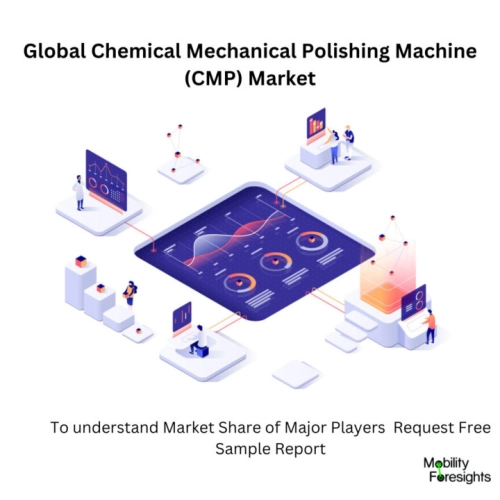
- Get in Touch with Us

Last Updated: Apr 25, 2025 | Study Period: 2024-2030
At each layer of the wafer, chemical mechanical polishing, or CMP, is a crucial step that is utilised repeatedly in the semiconductor manufacturing process to remove extra materials and provide a smooth surface.
On a polishing tool, the interplay of a pad and slurry accomplishes this. In CMP, the polishing pad surface might become coated with residue, so it's common practice to "dress" the pad with a diamond disc conditioner to regenerate a fresh pad surface topography and profile. This helps to keep the process conditions favourable.

The Global Chemical Mechanical Polishing Machine (CMP) Market accounted for $XX Billion in 2022 and is anticipated to reach $XX Billion by 2030, registering a CAGR of XX% from 2024 to 2030.
Surfaces are made extremely smooth (i.e., polished) by chemical mechanical polishing (CMP). Chemical mechanical polishing plays a crucial role in making nearly flawlessly flat (or planar) films during the production of advanced devices used in microelectronics and other fields of application.
This step also prepares the film surface for the deposition of subsequent layers. Since then, the demand for CMP tools and materials has steadily increased, and research and development (R&D) activities to create slurry formulations and equipment designs have increased quickly in response to the need to meet increasingly strict standards brought on by the miniaturisation of microelectronic devices.
In addition, a global assessment of the CMP industry's present state and expected future developments is required. It is also vital to provide a geographical breakdown of CMP equipment and material production facilities in relation to global sales and distribution, given the ongoing globalisation of markets and the shifting of many manufacturing facilities to lower-cost nations.
Such an assessment will help to create a more comprehensive understanding of the applications of CMP tools and materials both domestically and internationally, as well as of growth potential for these products.
This research was conducted for a number of reasons, including to provide an overview of global R&D activities related to the CMP industry, both within public and private organisations, and to demonstrate the most recent technological advancements that can help businesses find opportunities for process and productivity improvements and, consequently, positively impact their future market growth.
| Sl no | Topic |
| 1 | Market Segmentation |
| 2 | Scope of the report |
| 3 | Abbreviations |
| 4 | Research Methodology |
| 5 | Executive Summary |
| 6 | Introduction |
| 7 | Insights from Industry stakeholders |
| 8 | Cost breakdown of Product by sub-components and average profit margin |
| 9 | Disruptive innovation in the Industry |
| 10 | Technology trends in the Industry |
| 11 | Consumer trends in the industry |
| 12 | Recent Production Milestones |
| 13 | Component Manufacturing in US, EU and China |
| 14 | COVID-19 impact on overall market |
| 15 | COVID-19 impact on Production of components |
| 16 | COVID-19 impact on Point of sale |
| 17 | Market Segmentation, Dynamics and Forecast by Geography, 2024-2030 |
| 18 | Market Segmentation, Dynamics and Forecast by Product Type, 2024-2030 |
| 19 | Market Segmentation, Dynamics and Forecast by Application, 2024-2030 |
| 20 | Market Segmentation, Dynamics and Forecast by End use, 2024-2030 |
| 21 | Product installation rate by OEM, 2023 |
| 22 | Incline/Decline in Average B-2-B selling price in past 5 years |
| 23 | Competition from substitute products |
| 24 | Gross margin and average profitability of suppliers |
| 25 | New product development in past 12 months |
| 26 | M&A in past 12 months |
| 27 | Growth strategy of leading players |
| 28 | Market share of vendors, 2023 |
| 29 | Company Profiles |
| 30 | Unmet needs and opportunity for new suppliers |
| 31 | Conclusion |
| 32 | Appendix |